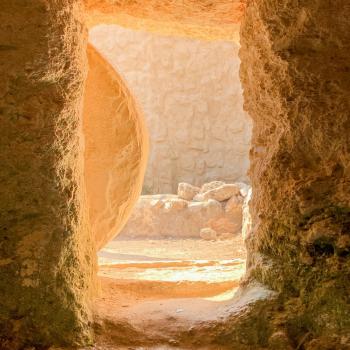In the Bible we read about the Nephilim who lived during the time of Noah before the Great Flood (Genesis 6:1-4). They are also mentioned again many years after the Flood in Numbers 13:33. Did they escape the Flood? Depending on your translation, they are also called “giants” along with the Rephaim and the Anakim. Who are they?
The word Nephilim first appears in Genesis 6:4, where the texts states that such beings were on the earth during the days of sexual unions between the “sons of God” and the “daughters of men.” The Hebrew word נְפִלִים is left untranslated as Nephilim in most English versions (e.g., NRSV, ESV, NET, NASB). However, the King James Version, New King James Version, the Septuagint (LXX), as well as the Latin Vulgate, translate this word as “giants” after the Greek word, γίγαντες (gigantes).

In Genesis 6 the Nephilim are said to be mighty warriors, heroes (gibborim). As Kosmala states, “Anyone who is exceptionally important or powerful in some field is a gibbor, e.g., Nimrod, “a mighty hunter before the Lord” (Gen. 10:9), but who was also a gibbor on the earth in other respects (v. 8).” (Hans Kosmala, “גָּבַר,” Theological Dictionary of the Old Testament [TDOT] 1977: 2:373–374). The Nephilim’s status as heroes or great warriors may have something to do with their designation as giants. In Numbers 13 they are mentioned again, and here they are said to be giants.
The Identity and Fall of the Nephilim
Speculations abound regarding the origin of the Nephilim. A common assumption is that these beings are the offspring of the sons of God, a group of fallen angels also known as the Watchers. According to ancient traditions, the Watchers left their heavenly abode and had sex with earth’s women (see B. J. Oropeza “Who are the Sons of God in Genesis 6?” ).
Since the Nephilim first appear in the same context of this union between the sons of God and the daughters of humans, interpreters often infer from this that the Nephilim were their offspring. If they were partially human (children of the “daughter of men”) and partially angelic (as children of the “sons of God”), this might be yet another reason why they grew to an abnormal size.
A careful reading of Genesis 6:1–4, however, does not explicitly state that the Nephilim were the children of this sexual union. Nevertheless, the inference is fairly clear, and that is what ancient Jewish and Christian sources often assumed regarding the Nephilim (compare 1 Enoch 6–11; 15–16; Jubilees 5:1–10; 7:21–22; Testament of Reuben 5.5–6; Philo, Questions on Genesis I.92; Justin Martyr, Second Apology 5).
Several possibilities are advanced concerning the origin of the term Nephilim. The word probably means in Hebrew “fallen ones.” According to Seebass, “The noun seems to embody the notion, so characteristic of ancient Israel, that something gigantic, something exalted, must necessarily fall” (Horst Seebass, “נָפַל,” TDOT 9:497). This implies several possible explanations for the term:
Moral fall?
One possibility is that the Nephilim fell away morally. But if we assume that they are the offspring of fallen angels, this apostasy would seem to refer more to their fathers (who rebelled against God) than them. Even so, it can be surmised that the Nephilim themselves were immoral (compare Genesis 6:5; Sirach 16.7; and the Book of the Watchers [1 Enoch 1–36]).
Miscarriage?
The root word Nêpel could mean an abortion or miscarriage, possibly identifying something abnormal about their birth originating from the immoral relationship between their fathers and earth women (compare Num 5:11–31).
Murderers?
They “fall” on others in the sense of killing them. This fits their character in ancient Jewish literature and generally in Genesis 9:6.
Killed?
They are the ones who “fall” and are killed. This assumes that God completely wiped them out in the Flood (Gen 6:17; compare Jubilees 10.3–5). We notice in the Wisdom of Solomon 14.6 that the giants are considered arrogant, and they perished in the Flood, but Noah survived on a boat.
This understanding perhaps has further biblical implications when compared to Ezekiel 32:20–28. This passage may be alluding to Genesis 6:1–4: it depicts the defeat of great warriors (compare Gen 10:8–9; Gordon J. Wenham, Genesis 1—15, WBC p. 143). Philo taught that Nimrod, the great warrior of Genesis 10:8, was one of the giants (De Gigantibus [On the Giants] 58–65).
The giants (gigantes) of Greek folklore likewise were defeated and imprisoned under the earth, as Wenham affirms.
This final option means that they were named “Nephilim” after they were already destroyed. If this is the most plausible option, then we do not know what they were called prior to their destruction.
Nephilim and Other Giants
Genesis 6 aside, we find only one other biblical reference to the Nephilim. When Moses sent the twelve tribal leaders to spy out the land of Canaan, they brought back a discouraging report in Numbers 13:32–33: “The land we explored devours those living in it. All the people we saw there are of great size. We saw the Nephilim there (the descendants of Anak come from the Nephilim)…” (NIV).
The NIV, in my opinion, does a poor job of translating this passage. The parentheses after “we saw the Nephilim there” make the comment that follows appear as though it were inserted by the biblical writer or redactor to give the reader a better understanding of the Nephilim: “(the descendants of Anak come from the Nephilim).”
In Hebrew, however, no parentheses appear in the text. A more literal reading of the phrase would be, “And there we saw the Nephilim, (the) sons of Anak of the Nephilim.” This better translation supports that the phrase was spoken by the spies who were lying or at best exaggerating. They continue to say, “We seemed like grasshoppers in our own eyes, and we looked the same to them.”
This passage connects the Nephilim with the Anakim (“people of the necklace”: Deuteronomy 1:28; 9:2), and the latter are comparable in size with the Rephaim (“great ones?”: though they go by different names: compare Deuteronomy 2:10‑11, 20‑21).
Og and Goliath
Og, king of Bashan, was a Rephaite whose bed or sarcophagus measured 9 by 4 cubits (perhaps thirteen feet long and six feet wide: Deut 3:11). The gigantic Philistine warrior, Goliath, was said to be a descendant of the “Raphah,” as were others (2 Sam 21:15–22; 1 Chron 20:4–8; see Deane Galbraith, “Giants,” Encyclopedia of the Bible and its Reception, 10:198–99). Goliath’s height at 4.5 cubits is not too impressive (a little over 6 1/2 feet tall based on the Septuagint and Dead Sea Scrolls : 4Q Sam [1 Sam 17:4]). The Hebrew and Vulgate texts have him at 6.5 cubits (over 9 1/2 feet tall).
But the size of these giants in no way compares with the Nephilim of Genesis 6 as described in non-canonical books, such as the Damascus Document (Dead Sea Scrolls)—these giants are the height of cedars and their bodies like mountains (CD 2.18–19).
Even more impressive (or unbelievable) is 1 Enoch 7 that has them at three hundred cubits high, which would make them taller than Godzilla! (Old Testament Pseudepigrapha, E. Isaac, 7.2). However, an alternative translation of this verse refers instead not to their height but to three kinds of offspring including Giants, Nephilim, and Elioud (Daniel Olson, Eerdmans’s Commentary on the Bible, 908).* In 1 Enoch these giants ate all the produce in the land, so the people would not give them anything else to eat. The giants then began eating the people. When the people groaned, God gave them justice, and through his archangel had the giants kill one another. After that, he sent the great Flood.
Did the Nephilim Survive the Flood?
In Numbers 13:33 the Nephilim appear again during Israel’s travels in the wilderness, which is supposed to be centuries after the Flood. If the Israelites saw the Nephilim in the land of Canaan, are we to assume that these are the offspring of the Nephilim from Genesis 6? Put differently, did the Nephilim survive the great Flood of Genesis 6–9?
Flood Survivors?
If we assume this to be the case (and not an inconsistency in the text), the great Flood may be interpreted as a local one, affecting the region of Mesopotamia but not other regions. Thus, it could be surmised that some of the Nephilim escaped the flood. Some scholars interpret the phrase “and also afterward” in Genesis 6:4 as referring to a time after the Flood, anticipating mention of the Nephilim in Numbers 13:33.
Others, however, believe this interpretation is hard to reconcile with the context of Genesis 6—9, which depicts the flood as wiping out all human life except Noah’s family (Gen 6:5—7:23; esp. 7:19). Consistent with this view, the phrase “and also afterward” could mean that the Nephilim were living at the time before the Flood and also “after” the advent of the sons of God. And then they were all wiped out by the Flood.
Certain rabbinic literature understood the phrase “and afterward” as referring to the 120‑year period before the flood (Gen 6:3). Thus, a clearer paraphrase of the early verses in Genesis 6 might read: “In the days when the population increased, the sons of God had sexual unions with earth’s women. The Nephilim were born to them at that time, and also afterward—over the span of 120 years before the flood—whenever the sons of God had sex with women, Nephilim were born. These Nephilim were the heroes of old” (B. J. Oropeza, 99 Answers to Questions about Angels, Demons, p. 187 note 40). Even so, this alternative does not explain how the Nephilim reappear in Numbers 13.
Non-Survivors?
Some options along this line include that the Nephilim in Genesis 6 and Numbers 13 are two unrelated peoples who happen to have the same name. But this seems unlikely, given the great stature of both peoples.
Another possibility is that the “new” Nephilim are only named as such because they share characteristics in common with the older Nephilim: great size and violent behavior, for example, even though the Nephilim in Numbers are not actual descendants of the Pre-Diluvian people.
Perhaps a better explanation of this sort is that the spies reported false information in Numbers 13. The ten spies who gave a negative report, mentioning the Nephilim and saying that they “seemed like grasshoppers” when compared with them, clearly exaggerated. If their report implies false information, they may have lied when they claimed that the Anakim were descendants of the Nephilim. Granted, they may have appeared to be similar to the Nephilim of old because of their great size, but the Anakim (and Rephaim) may not have been considered actual descendants of the Nephilim. Similarly, Ashley writes, “As the text stands [Num 13:31–33] it is clear that the majority report [of the spies] is condemned as false and faithless.” (Timothy R. Ashley, The Book of Numbers, NICOT; 1993:243).
Conclusion
Although the origin of the Nephilim remains shrouded in mystery, we can suggest that, according to Scripture, they perished in the Flood of Noah’s day.
* Special thanks to Victor Hill of academia.edu for this lead.


















